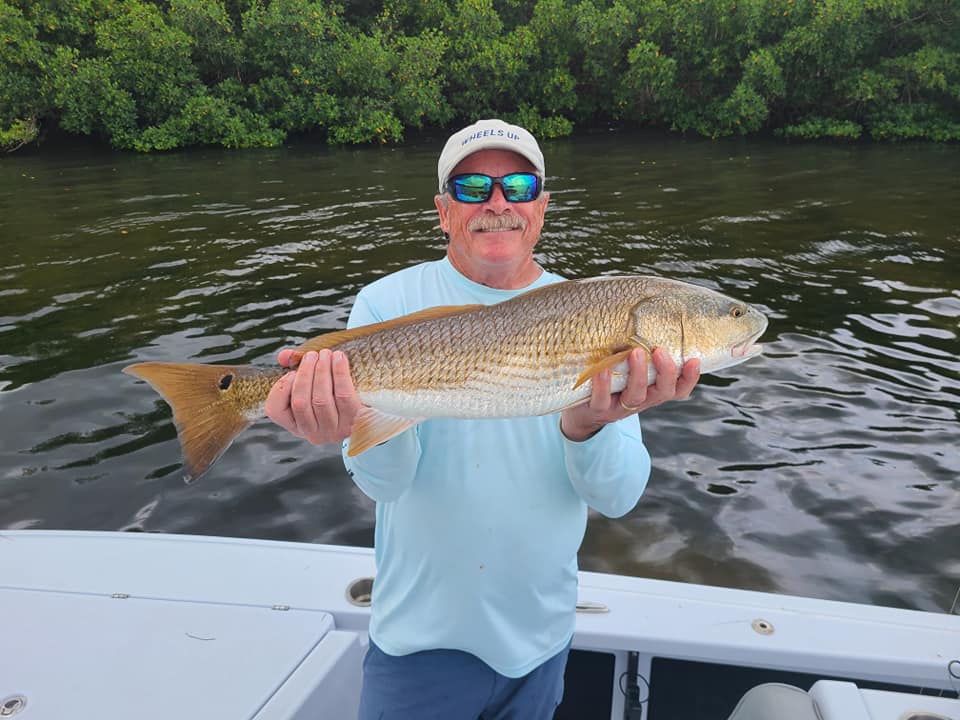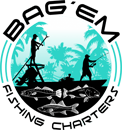Last Updated on June 11, 2025 by Eric
Tampa Bay sits in the heart of Florida’s central Gulf Coast, buffered by barrier islands and fed by dozens of creeks. Warm weather settles in by late May and lingers to early October, keeping surface temperatures near 86 °F for weeks at a time. That heat drives shrimp, crabs and finfish into lush grass beds and mangrove shade, and the redfish follow. Local reds grow fast on the bay’s year‑round forage, often reaching the upper slot in three years. Sub‑legal “rat” reds move in schools across open flats while mature slot fish station under roots or roam oyster points with the tide. Summer’s long daylight and predictable southeast wind give fishermen a wide window for exploration, but success still hinges on reading subtle habitat changes and managing the heat.
Seasonal Behavior Patterns
Summer changes both metabolism and movement. Higher water temperature increases the redfish’s need for dissolved oxygen while also accelerating digestion, so feeding windows compress into the cooler ends of the day. Look for:
-
Dawn blitzes – Thirty minutes of frantic surface action on schooling bait over knee‑deep grass before direct sun raises the temperature.
-
Mid‑morning shadow hops – Slot reds transition under mangrove overhangs or float in the shade of a spoil‑island bank.
-
Late‑afternoon flood pushes – A rising tide after three o’clock re‑introduces oxygenated gulf water, re‑activating reds that sulked through lunch.
Summer also shrinks home ranges. Many fish spend the entire season on one flat, leaving only to visit adjacent troughs on a low tide. Tracking a particular school for several days pays dividends because Tampa Bay reds are highly territorial once water tops 80 °F.

Prime Habitat Zones
The bay spans more than 400 square miles. Rather than running the whole expanse, identify micro‑zones that reliably collect bait. Productive summer redfish stations share three traits:
-
Hard‑bottom potholes inside healthy grass – Firm sand spaces five to 20 feet wide concentrate shrimp and pinfish, giving the redfish a clean strike zone.
-
Tidal edges around oyster bars – Broken shell filters water, creates current seams and offers a buffet of small crabs. Target the inside edges on the first hour of incoming water.
-
Mangrove points with adjacent mud depressions – Redfish stage in the depression, then slide up the mud lip to ambush as fiddler crabs drop from roots.
Backcountry creeks between Weedon Island and Riviera Bay produce consistent numbers after heavy afternoon thunderstorms. The fresher surface layer cools the upper foot of water, and reds respond within minutes.
Tackle and Rigging Choices
Summer redfish are not tackle‑shy, but heat and wind place premium on accuracy. A balanced 7‑foot medium‑action graphite rod rated for 10‑20 lb braid lets you cast small baits without overshooting tight pockets. Pair it with a 2500‑3000 series reel and 20 lb braid. Top with a 30 lb fluorocarbon leader when working oysters; drop to 20 lb around clear grass to improve lure action. Circle hooks from 2/0 to 3/0 handle most natural baits while protecting fish that must be released. When throwing artificials, use a loop knot to keep hard baits moving naturally and a snug knot for jig heads that drag the bottom. Summer wind often gusts across an open flat, so keep a few 1⁄8‑ounce split‑shot handy to pin live baits low and prevent drift.
Live Bait Strategies
Redfish eat almost anything, yet certain summer offerings outshine the rest:
-
Scales sardine “whitebait” – Free‑line a lively sardine on 2/0 circle hook along channel edges when the tide first turns in. Chumming with compressed oatmeal laced with oily pilchard pieces fires up the bite.
-
Pinfish – Nose‑hooked or tail‑hooked, a three‑inch pinfish fished under a popping cork draws bruiser reds hiding in thick turtle grass.
-
Cut ladyfish – When heat or red tide makes whitebait scarce, fresh half‑inch ladyfish steaks laid on bottom soak scent that travels far in warm water.
-
Small blue crabs – Pin a crab through the swimmer fin and lobster‑style cast it beneath overhanging roots.
Position the boat up‑wind and up‑current of the strike zone to avoid hull slap. Summer reds often track scent trails for several minutes before locating the bait, so patience trumps constant repositioning.
Artificial Lure Playbook
Artificial presentations keep you in the game when baitfish scatter or you want to cover water fast. Rotate through three confidence categories:
-
Topwater walkers – Bone‑finish spook‑style plugs excel from civil dawn to full sunrise. Fan‑cast over sparse grass in three feet of water and maintain a wide walk so hungry reds can track the rattle.
-
Soft plastic jerk shads – Rig weedless on a 4/0 screw‑lock hook for glide through floating grass fragments after midday storms. Watermelon seed or copper penny patterns match local pinfish flash.
-
Quarter‑ounce paddle tail jigs – When the tide strengthens, paddle tails tick bottom across pothole rims. Retrieve just fast enough to trigger vibration, not so fast that the lure rolls.
Vary cadence every 20 yards until a fish responds. Summer reds sometimes strike hard once then trail the lure. Drop the rod tip, pause one second, and resume a slow crawl to trigger the final eat.

Sight Fishing on the Flats
Clear summer mornings give world‑class sight opportunities inside Picnic Island, Bishops Harbor and Joe Island. Keys to success:
-
Approach with the sun at your back and the wind quartering off your casting shoulder.
-
Wear high‑contrast polarization in copper or amber so tails and shadows pop against turtle grass.
-
Step on the poling platform rather than running the trolling motor in water less than two feet. Vibrations carry far under a calm surface.
-
Present six feet ahead of the fish’s line, not at its head. Reds rarely react well to a lure falling on their nose in glassy conditions.
-
After the hook‑set keep the rod tip low. Lifting straight up pulls against the fish’s broad shoulders and can tear soft summer tissue.
A well‑placed cast to a single tailer often produces the day’s largest fish because Tampa Bay trophies run alone or with one partner through shallow sand troughs.
Managing Tides Wind and Heat
Tides swing three to four feet through summer new‑moon periods, with the strongest currents just after sunrise and a secondary push before dark. Begin at a shallow interior flat on the first of incoming water, then hop to outer bars as the flat fills. Reverse the pattern as water drains.
Afternoon sea breeze builds by one o’clock. Plan a drift angle that lets wind and tide align; fighting cross‑energy drifts wastes casts. When breeze opposes current, stake a push pole or drop a shallow‑water anchor and power fish a tight zone instead.
Heat stress affects both fish and fisherman. Bring a simple pocket thermometer. When surface temperature on your flat reads 90 °F, slide to a nearby trough six inches deeper. Even that slight change can provide enough cooler water to reactivate a bite. Drink a quart of water per hour, rotate a wide‑brim hat between casts and keep sunscreen off lures to avoid chemical taste.
Etiquette Conservation and Regulations
The Tampa Bay watershed supports millions of fishing trips each year, and summer traffic is heavy. Practice low‑impact habits:
-
Idle through marked channels rather than planing off early. Prop scars in sea grass take a decade to heal.
-
Limit motor noise by shutting down 100 yards before a visible school. Polling or drifting increases hookups and leaves the fish settled for the next boat.
-
Respect wading fishermen by passing outside their casting zone.
-
Handle reds carefully. Wet your hands, keep the fish in the water until camera gear is ready and support the belly, not just the jaw.
-
Know the rules. In mid‑2025 the Tampa Bay management zone allows one redfish per person daily between 18 and 27 inches, with a vessel limit of two. Regulations can change after seagrass or red tide assessments, so verify with Florida Fish and Wildlife Conservation Commission before your trip.
Healthy redfish stocks rely on habitat. Pack out every scrap of line, anchor lightly on sand, and volunteer for local shoreline cleanups when possible.

Troubleshooting Common Challenges
Red Tide Intrusion
When harmful algae bloom drifts into middle bay, move east toward Oldsmar where tidal flushing is stronger. Oxygenated fresh water from the Alafia River also buffers small pockets on outgoing tide.
Bait Disappears
Summer thunderstorms can scatter whitebait overnight. Stash a few bags of preserved shrimp or an extra jar of fish‑based scent in the cooler. Pair them with paddle tails to stretch the day.
Spooked School
If a pod blows out after one bad cast, give them fifteen minutes. Sit quietly and let mullet resume normal movement. Reds often circle back along the same grass edge, and patience will out‑produce chasing them across a flat.
Snagged in Mangroves
Rather than yanking, open the bail and pole over. Reds shove deep after the hook‑set. Staying calm preserves leader integrity and keeps the school relaxed.
Finish Strong on the Flats This Summer
Tampa Bay’s summer redfishing rewards preparation, timing, and the ability to read subtle changes on the water. Early morning pushes bring fish onto the flats, while falling tides pull them tight to structure. Each stage of the day brings new opportunities, and the fishermen who adjust with purpose are the ones who stay hooked up from first light to last cast.
Bag’em Fishing Charters, led by Captain Bucky, delivers that kind of dialed-in experience. Years of running the bay have sharpened his approach to seasonal patterns, local pressure, and small environmental shifts that most overlook. From poling quietly into tailing schools at dawn to working oyster cuts as the water drops, every move has intent behind it.
Ready to turn a summer day into something more? Book your trip with Bag’em Fishing Charters today and fish Tampa Bay with someone who knows it inside and out.


